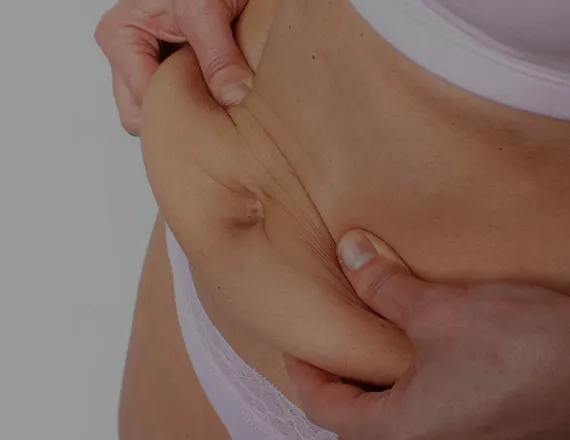
Abdominoplasty
Your Affordable Abdominoplasty in Tunisia
Get a flat stomach and a slim waistline thanks to abdominoplasty. A mastered surgical technique for a natural and lasting result.
How does it work?
What is abdominoplasty?
Abdominoplasty is a procedure aimed at removing excess fatty tissue and skin folds in the central and lower part of the abdomen, in order to stretch the abdominal wall and improve the appearance of a prominent abdomen. Diet and exercise alone cannot produce this result because this situation is often accompanied by the separation of the abdominal muscles from each other and the weakening of the abdominal wall. Stretch marks, where possible, are removed with the excess skin that is removed, however, stretch marks on the remaining abdominal wall will be improved. There will always be a permanent scar from the surgery which, depending on the type of surgery, may also extend from side to side. Abdominoplasty is a demanding operation and is generally performed in an operating room during a hospital stay. It can be accompanied by abdominal liposuction and generally requires a stay of 1 to 3 days.
Who is a good candidate for abdominoplasty?
A good candidate for abdominoplasty in Tunisia is generally a person who presents specific problems in the abdomen. This may include excess skin and fat in the abdominal region, as well as abdominal ptosis, i.e. sagging or relaxation of the muscles and tissues. Ideal candidates for this operation are those who have already tried non-surgical methods to regain a flat stomach, such as regular exercise and a balanced diet, but have not obtained the desired results.
Abdominoplasty can effectively help eliminate excess skin and fat, while tightening weakened abdominal muscles. It is important that the candidate is in good overall health, with realistic expectations regarding the results of the surgery. A prior consultation with a qualified plastic surgeon will determine if abdominoplasty is the best option to achieve the desired aesthetic goals and if the patient is ready to undergo surgery to stretch the abdominal muscles and obtain a more toned figure.

What are the goals of abdominoplasty?
Abdominoplasty, also known as abdominal plastic surgery or tummy tuck, is a cosmetic surgical procedure aimed at reshaping and firming the abdominal region. The main objective of abdominoplasty in Tunisia is to obtain a flat and toned stomach by eliminating accumulated excess skin and fat, as well as strengthening the muscles of the abdominal wall. People who have undergone significant weight loss and who present significant skin laxity in the abdomen often seek this operation. In addition to aesthetic improvement, abdominoplasty can also contribute to improving patients’ self-confidence and overall well-being.
How to prepare for abdominoplasty in Tunisia?
Abdominoplasty in Tunisia is a major surgical procedure and therefore requires special preparation.
First, the future patient must:
- Stop smoking, if they are a smoker. Cigarette smoke promotes the appearance of infections in surgical wounds resulting from a future abdominoplasty. In addition, it modifies blood flow to the skin, slowing down the healing process of these surgical wounds. In general, doctors recommend stopping smoking at least two weeks before surgery and, if the patient wants to start again, only resuming two weeks after surgery;
- Lose weight and reach the ideal body weight considered by the doctor who will perform the operation;
- Stop taking the contraceptive pill. Stopping its use reduces the risk of thrombosis;
- Stop taking any anticoagulant medication (warfarin);
- Inform the medical staff of any allergies to medications (analgesics, sedatives, anesthetics, etc.);
To ensure that the general anesthesia does not cause complications, it is essential that the patient be completely fasting from at least the previous evening on the day of surgery. Complete fasting consists of abstaining from all food and drink other than water; water is allowed up to a few hours after surgery.
What is the price of abdominoplasty in Tunisia?
The price of abdominoplasty in Tunisia can vary depending on the specific difficulty of the procedure. The average cost is €2300 and includes all expense items (plastic surgeon, anesthesiologist, operating room, hospitalization, nursing staff, dressings and post-operative assessments). Abdominoplasty prices in Tunisia remain much more competitive than those in European and American countries. Opting for Tunisia for your tummy tuck surgery means saving money on your procedure while benefiting from the highest standards of hygiene, quality and professionalism.
Your health, our priority.
Request your free quote.
What are the different types of abdominoplasty?
Traditional Abdominoplasty
Traditional abdominoplasty involves:
- An incision made from side to side just above the pubic region;
- Another incision made to free the navel from the surrounding skin;
- The skin is detached from the abdominal wall to reveal the muscles and fascia that need to be stretched, the muscular fascia is “pulled” with sutures;
- The remaining skin and fat are stretched by removing the excess and closing the remaining part;
- The stem of the old navel is thrown through a new hole and sutured in place;
- Liposuction is often performed to finish the transition areas of abdominal sculpting;
- Any excess fluid is drained;
Mini-abdominoplasty
A partial (or mini) abdominoplasty operation involves:
- a smaller incision;
- the skin and fat of the lower abdomen detach from the muscular aponeurosis in a more limited way. The skin is pulled down and the excess is removed;
- Sometimes the navel pedicle is split from the muscle below and the navel slides further along the abdominal wall;
- Sometimes part of the aponeurosis of the abdominal muscles is “pulled”;
- Often, liposuction is performed to refine the transition area;
- The skin flap is sewn in place;
What procedures can be combined with abdominoplasty in Tunisia?
Abdominoplasty is a common surgical procedure to remove excess skin and fat from the abdominal region. This procedure is combined with other surgical procedures to improve aesthetic results. For example, the doctor can perform liposuction at the same time as abdominoplasty to eliminate unwanted fat deposits in the surrounding areas. In addition, an abdominal wall plasty can be performed to strengthen the abdominal muscles and improve posture. Finally, breast cosmetic surgery procedures, such as breast augmentation or breast reduction, can be combined with abdominoplasty to obtain a more balanced and harmonious figure. It is important to discuss all options with a qualified surgeon to determine the best approach to achieve your aesthetic goals.
What is the postoperative phase after abdominoplasty?
At the end of the abdominoplasty and upon waking up after general anesthesia, hospitalization is always planned. The length of hospitalization varies depending on the type of abdominoplasty: for example, for traditional abdominoplasty operations which are quite invasive, hospitalization can last up to 4 days, while for partial abdominoplasty operations which are less invasive than the previous ones, hospitalization lasts up to two days. Throughout the duration of hospitalization, medical personnel periodically monitor the patient’s vital signs. In addition, they ensure continuous drainage of blood and other fluids from the surgical wound, through a special tube. The medical team removes this small tube shortly before discharge. For discharge and especially for the return home, the patient must request the support of a close relative or friend.
The most important medical recommendations for the postoperative phase are as follows:
- Respect a rest period from any strenuous activity (lifting weights, intense exercise, etc.). Doctors consider it necessary to follow this recommendation for at least 6 weeks;
- Cleaning the wound and the protective dressing that the operating surgeon applied at the end of the operation;
- Ban on smoking for at least two weeks. The effects of smoking have already been discussed many times;
The duration of recovery after abdominoplasty depends on the type of procedure used by the plastic surgeon. For complex operations, such as traditional abdominoplasty, the recovery phase can take between 3 and 6 months; for simpler operations, such as mini-abdominoplasty, it can take 6 weeks or a little more. Despite recent advances in plastic surgery, the surgical incision performed during abdominoplasty still leaves a scar.
Recovery time after abdominoplasty
Abdominoplasty, or tummy tuck, removes excess skin and fat, tightening the abdominal muscles. Like any surgical operation, it requires a specific recovery time. Convalescence allows the body to heal properly and obtain the best possible results. In general, the recovery period after abdominoplasty ranges from a few weeks to several months. This duration varies depending on the extent of the intervention, as well as the healing capacity of each individual. During the first few weeks, it is necessary to follow the recommendations given by the doctor:
- wearing a compression garment,
- limiting intense physical activity
- observing a healthy lifestyle.
What are the possible complications after abdominoplasty?
Complications from abdominoplasty in Tunisia are rare, but possible. They are of two types: those related to anesthesia and those related to surgery. As for the former, they can sometimes be serious, but are rare in people who start from a good general condition. Rarely, in some patients, scars remain red and visible. However, scientific progress has allowed surgeons to treat these scars with lasers. Furthermore, the risk of complications increases in patients with diabetes or heart or lung disease.
Our advantages


What are the advantages and expected results of abdominoplasty?
Abdominoplasty cosmetic surgery, also known as a tummy tuck, offers many significant advantages and expected results. First, abdominal plasty removes excess skin and fat, leading to a flatter, more toned stomach. In combination with liposuction, abdominoplasty can also refine the silhouette by eliminating stubborn fat deposits. Furthermore, this procedure helps reposition the abdominal muscles. As a result, the patient obtains a stronger, more stable abdominal section and improved posture. The expected results of abdominoplasty are:
- a more aesthetic appearance of the abdomen,
- increased self-confidence,
- general improvement in body image.
Success rate of abdominoplasty in Tunisia
Abdominoplasty in Tunisia has a success rate of 85%. This means that the vast majority of patients obtain satisfactory results. Indeed, they notice a noticeable improvement in the appearance of their abdomen and an increase in their self-confidence. Several factors contribute to this high success rate. These include, for example, the surgeon’s expertise, compliance with postoperative recommendations and the patient’s general condition. Despite this success, it should be noted that each individual reacts differently to surgery. This is why adequate medical follow-up is necessary to optimize results and minimize potential complications.
Contact and request a quote for abdominoplasty in Tunisia
Our team is always at your disposal to assist and guide you through all the procedures for abdominoplasty in Tunisia. If you are tempted to have your tummy tuck surgery abroad and you wish to organize your stay in Tunisia with a serious and experienced agency, trust the professionals of Tunisia Destination Santé. We accompany you step by step in the preparation of your file and in the organization of your stay. Do not hesitate to contact us for more information and to request a free, non-binding quote.
—
Frequently Asked Questions
Bariatric surgery and reconstructive surgery are closely linked in patients who have undergone massive weight loss. Bariatric surgery, such as gastric bypass, gastric banding or sleeve gastrectomy, helps lose a large amount of weight. However, this rapid and significant weight loss can lead to excess skin and skin laxity. Thus, these patients require reconstructive surgery such as abdominoplasty. They will thus be able to remove excess skin and improve their figure.
Diastasis recti is a separation of the abdominal muscles, often due to pregnancy or significant weight gain. The most effective treatment to correct severe diastasis is abdominoplasty. Indeed, this operation makes it possible to tighten the abdominal muscles and remove excess skin, making the stomach flatter and firmer.
In general, you must reach a stable weight close to your ideal weight before undergoing abdominoplasty. Furthermore, surgeons advise maintaining this stable weight for at least six months to optimize results and reduce the risk of complications.
After bariatric surgery, abdominoplasty often has to manage a greater excess of skin and increased skin laxity. Patients may also have nutritional deficiencies due to bariatric surgery, which can affect healing. This is why careful assessment and adequate preparation are essential.
Abdominoplasty in men may differ from that in women in terms of incision placement and the tension applied. Indeed, men tend to accumulate fat differently, often around the waist. This is why abdominoplasty in men may require specific adjustments to obtain a satisfactory aesthetic result.
The superior high tension technique in abdominoplasty reduces tension on the final scar by distributing tension over a larger skin surface area. Consequently, there is an improvement in scar quality and a reduction in the risk of hypertrophic or keloid scars.
You should wait at least six months to a year after a pregnancy before undergoing abdominoplasty. This allows the muscles and skin to return to their pre-pregnancy state and ensures that you do not have immediate plans for another pregnancy, which could compromise the results of the procedure.
In general, the scars from abdominoplasty are located in the lower abdomen, from hip to hip, and around the navel. In addition, they are designed to be hidden under clothing and underwear. The quality of the scars depends on the technique used, as well as the healing capacity of each individual.
Like any surgery, abdominoplasty has potential risks and complications, including infection, hematomas, seromas, hypertrophic scars, and healing problems. Note that pre-operative consultation with your surgeon helps minimize these risks.
Liposuction is ideal for eliminating localized fat deposits, while abdominoplasty is more suitable for removing excess skin and tightening the abdominal muscles. The choice depends on your specific needs and the condition of your skin and abdominal muscles.
Pain after abdominoplasty can vary, but is generally moderate to severe in the first few days, then gradually decreases. Adequate pain management with medications prescribed by your surgeon is essential for comfortable recovery.
Yes, but it is important to wait for your surgeon’s approval before resuming any sporting activity. In general, the patient resumes light activities after about four to six weeks, while more intense exercises require a longer recovery period.
French Social Security may cover a mini-tummy tuck if the procedure is medically justified, for example in the case of sequelae of morbid obesity or a ventral hernia. However, a prior agreement request must be submitted.
Social Security may partially cover abdominoplasty if it is medically necessary, for example in the case of major sequelae of massive weight loss. An assessment by a medical advisor is necessary to determine eligibility.
Abdominoplasty is not a weight loss method, but it can lead to a significant reduction in size by removing excess skin and fat. Results vary depending on each patient, but a reduction of several centimeters in waist size is common.
